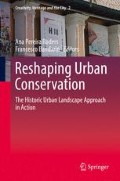Abstract
This chapter focuses on Lijiang City, China, one of the most controversial heritage sites in China. This site suffers from an excess of mass tourism, where economic exploitation seriously undermines the conservation of the site. The difficulties in dealing with tangible and intangible aspects are investigated while also addressing the issue of institutional fragmentation. Indeed, the site is composed of three different villages, with no coordination among them. Focusing on the major two (Dayan and Shuhe), a tension between conservation and exploitation emerges, with an interesting articulation of the notion of conservation. Neither site is able to find an ideal balance between conservation of the material aspect (tangible) and the social fabric of local population (and the Naxi minority in particular). Attempts to achieve this balance have led to diverging approaches and results; one site protects the artifact but feigns the social fabric, while the other has created a new area in the village to deflect visitor attention, protecting the old town and its social and agricultural activity.
Access this chapter
Tax calculation will be finalised at checkout
Purchases are for personal use only
Notes
- 1.
We would like to thank Janli Yu from CACH, Beijing, for helping update this data.
References
Bandarin, F., & van Oers, R. (Eds.). (2014). Reconnecting the City: The Historic Urban Landscape Approach and the Future of Urban Heritage. Oxford: Wiley-Blackwell.
Caddison, A. C. (2007). Disappearing world. London: Collins.
du Cros, H. (2006). Managing visitor impacts at Lijiang, China. In A. Leask & A. Fyall (Eds.), Managing world heritage sites. Butterworth-Heinemann.
Guo, Y., Zan, L., & Liu, S. (2008). The management of cultural heritage in China. General trends and a micro-focus on the Luoyang municipality. Egea, Milano (available as print-on-demand at www.egeaonline.it).
McKann, C. F. (2001). The good, the bad and the ugly: observations and reflections on tourism development in Lijiang, China. In C. B. Tan, C. H. Cheung, & H. Yang (Eds.), Tourism, anthology and China. Bangkok: White Lotus Press.
Smith, J. (2010). Marrying the old with the new historic urban landscape. In R. van Oers, S. Haraguchi (Eds.) Managing historic cities, World heritage papers # 27.
Unesco. (2007). Decision 32COM 7B.67 – Old Town of Lijiang (China) (C 811). http://whc.unesco.org/en/decisions/1674
Unesco. (2008) MISSION REPORT Old Town of Lijiang (China) (811), 10–19 January, WHC-07/31.COM/7B.
Unesco Bangkok. (2007). http://globalheritagefund.org/index.php/in_the_news/press_releases/ghf_applauds_lijiang_ancient_town_receiving_2007_unesco_award.
Van Oers, R. (2010). Managing cities and the historic urban landscape initiative – An introduction. In R. van Oers, & S. Haraguchi (Eds.). Managing historic cities (World heritage papers, 27). Paris: UNESCO World Heritage Centre.
Wang, Y. (2007). Customized authenticity begins at home. Annals of Tourism Research, 34(3), 789–804.
Wang, T., & Zan, L. (2011). Management and presentation of Chinese sites for Unesco World Heritage List. Facilities, 29(7/8), 313–325.
Yamamura, T. (2004). Authenticity, ethnicity and social transformation at World Heritage Sites: Tourism, retailing and cultural change in Lijiang, China. In D. Hall (Ed.), Tourism and transition, governance, transformation and development. Oxford: CABI Pub.
Zan, L. (2011). Preservation and exploitation. Lijiang old town, China. http://www.youtube.com/watch?v=mnVYVzY6U3U
Zan, L. (2014a). Cultural heritage in China between policies, development, professional discourse and the issue of managing. Public Archaeology Journal, 13(1–3), 99–112.
Zan, L. (2014b). New approaches to heritage administration in China. In C. Smith (Ed.), Encyclopaedia of global archaeology: Cultural heritage management section. New York: Springer.
Author information
Authors and Affiliations
Corresponding author
Editor information
Editors and Affiliations
Rights and permissions
Copyright information
© 2019 Springer Nature Singapore Pte Ltd.
About this chapter
Cite this chapter
Zan, L., Wang, T. (2019). Conservation and Exploitation: Governance and Sustainability Issues: The Case of Lijiang. In: Pereira Roders, A., Bandarin, F. (eds) Reshaping Urban Conservation. Creativity, Heritage and the City, vol 2. Springer, Singapore. https://doi.org/10.1007/978-981-10-8887-2_18
Download citation
DOI: https://doi.org/10.1007/978-981-10-8887-2_18
Published:
Publisher Name: Springer, Singapore
Print ISBN: 978-981-10-8886-5
Online ISBN: 978-981-10-8887-2
eBook Packages: Social SciencesSocial Sciences (R0)

